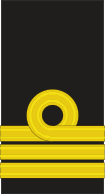Commander (Royal Navy)

Commander (often abbreviated Cdr) is a senior officer rank of the Royal Navy of the United Kingdom. It is immediately junior to captain and immediately senior to the rank of lieutenant commander. Officers holding the junior rank of lieutenant commander are not considered to be commanders.
History
The title (originally 'master and commander')[1] originated in around 1670 to describe naval officers who commanded ships of war too large to be commanded by a lieutenant, but too small to warrant the assignment of a post-captain, or (before about 1770) a sailing-master who was in charge of a ship's navigation.[2] These ships were usually unrated sloops-of-war of no more than 20 guns, fireships, hospital ships and store ships.[3]:127 The commanding officer of this type of ship was responsible for both sailing and fighting the ship and was thus its 'master and commander'.
Before 1750 the rank was broadly considered as the limit of advancement for those without patronage, especially those who had been promoted from among a ship's crew.[4] By contrast those with Parliamentary supporters or family connections were more likely spend only a nominal period as master and commander of a sloop before being elevated to post-captain. From 1718 the Navy List began recording an officer's date of appointment to the rank of master and commander, with the intention of establishing seniority as a guide to promotion, but there is little evidence that this carried through into actual appointments.[3]:130
Over the later eighteenth century the rank evolved into a more regular stage of service between lieutenant and captain. The Royal Navy shortened 'master and commander' to 'commander' in 1794;[5] however, the term 'master and commander' remained (unofficially) in common parlance for several years.[6]
The rank was a popular recognition of service during the Napoleonic Wars, resulting in promotion of more commanders than there were commands; in 1812 the Navy List recorded 586 commanders against 168 available vessels. Commanders unable to secure a ship were left ashore on half-pay, with limited prospects for future advancement. This promotions bottleneck was addressed from 1827 with the introduction of commanders as a second-in-command on larger vessels.[7]:98
In the 20th and 21st centuries, the rank has been assigned the NATO rank code of OF-4.
Seniority and usage
A commander in the Royal Navy is senior to an officer holding the rank of lieutenant commander but junior to a captain. A commander may command a frigate, destroyer, submarine, aviation squadron or shore installation, or may serve on a staff. Formerly equivalent to the Army rank of major,[8] a commander is now equivalent in rank to a lieutenant colonel in the British Army or a wing commander in the Royal Air Force. The rank of wing commander was derived from the naval rank of commander via the usage in the World War I Royal Naval Air Service.
The rank insignia of a commander features three rings of gold braid with a loop in the upper ring.[9]
References
- ↑ See also: Master and Commander by Patrick O'Brian.
- ↑ Rodger, N. A. M. (2001). "Commissioned officers' careers in the Royal Navy, 1690–1815". Journal for Maritime Research 3 (1): 88–89. doi:10.1080/21533369.2001.9668314.
- 1 2 Baugh, Daniel A. (1965). British Naval Administration in the Age of Walpole. Princeton University Press. ISBN 978-0691051079. OCLC 729683642.
- ↑ Rodger 2001, pp. 88-89.
- ↑ Hickox, Rex (2005). All You Wanted to Know about 18th Century Royal Navy: Medical Terms, Expressions and Trivia. Bentonville, Arkansas: Rex Publishing. p. 30. ISBN 978-1-4116-3057-4. Retrieved 7 September 2015.
- ↑ "Why is the Colonel called a 'Kernal?'". Naval Historical Center. 1998.
- ↑ Lavery, Brian (2012). Nelson's Navy: The Ships, Men and Organisation, 1793-1815. Naval Institute Press. ISBN 9781591146124.
- ↑ The Royal Kalendar, and Court and City Register for England, Scotland, Ireland and the Colonies. London: Oxford University. 1835. p. 148. Retrieved 7 September 2015.
- ↑ "Uniforms and Badges of Rank at Royal Navy website". Retrieved 7 September 2015.
| Commissioned officer ranks of the British Armed Forces | |||||||||||||
|---|---|---|---|---|---|---|---|---|---|---|---|---|---|
| NATO rank code | Student officer | OF-1 | OF-2 | OF-3 | OF-4 | OF-5 | OF-6 * |
OF-7 ** |
OF-8 *** |
OF-9 **** |
OF-10 ***** | ||
| Royal Navy | O Cdt | Mid | SLt | Lt | Lt Cdr | Cdr | Capt | Cdre | RAdm (list) |
VAdm (list) |
Adm (list) |
Adm of the Fleet | |
| Royal Marines | 2Lt | Lt | Capt | Maj | Lt Col | Col | Brig | Maj-Gen | Lt-Gen | Gen (list) | |||
| Army | O Cdt | 2Lt | Lt | Capt | Maj | Lt Col | Col | Brig | Maj-Gen (list) |
Lt-Gen (list) |
Gen (list) |
FM | |
| Royal Air Force | Off Cdt / SO | APO / Plt Off | Fg Off | Flt Lt | Sqn Ldr | Wg Cdr | Gp Capt | Air Cdre | AVM | Air Mshl | Air Chf Mshl (list) |
MRAF | |